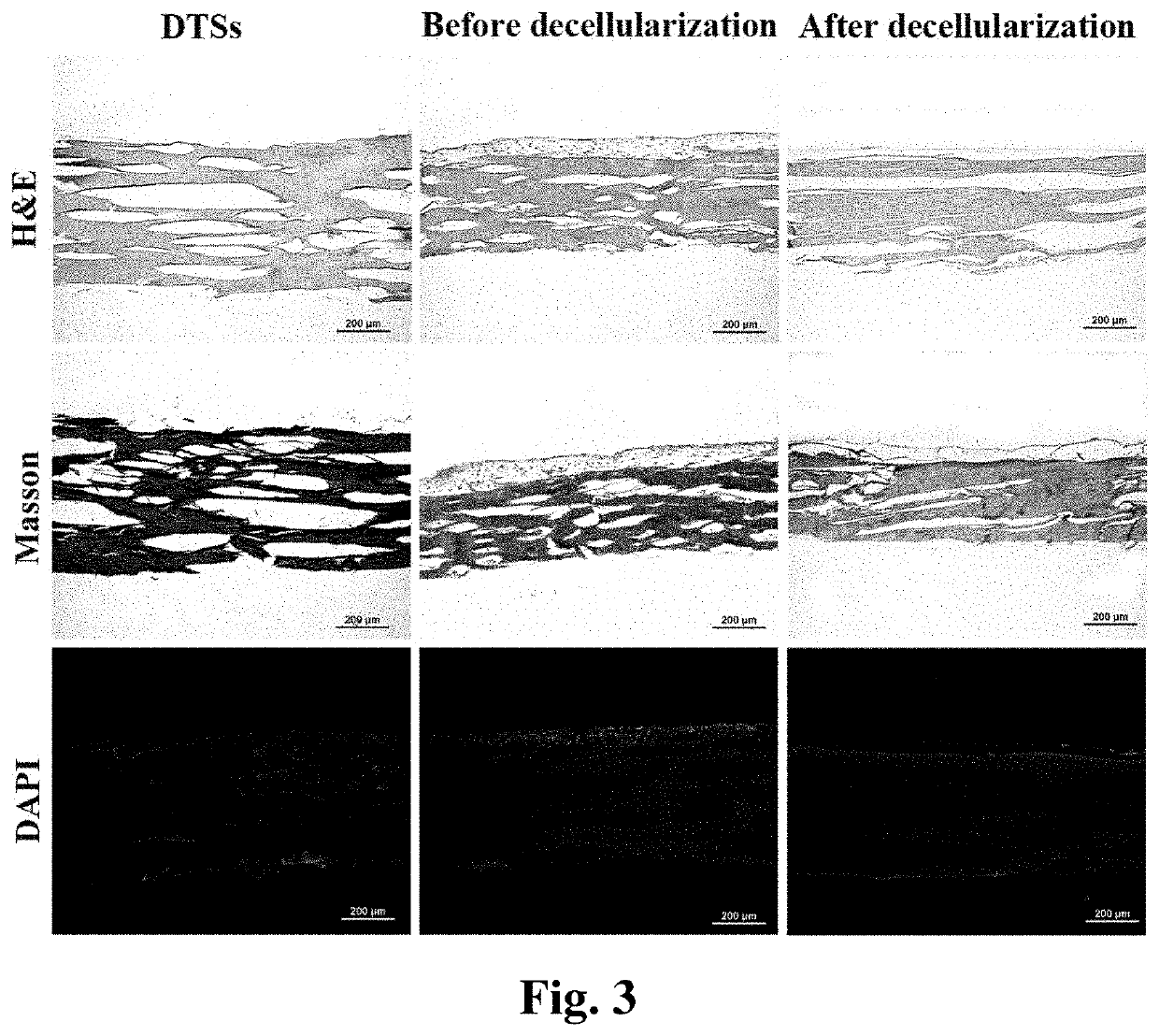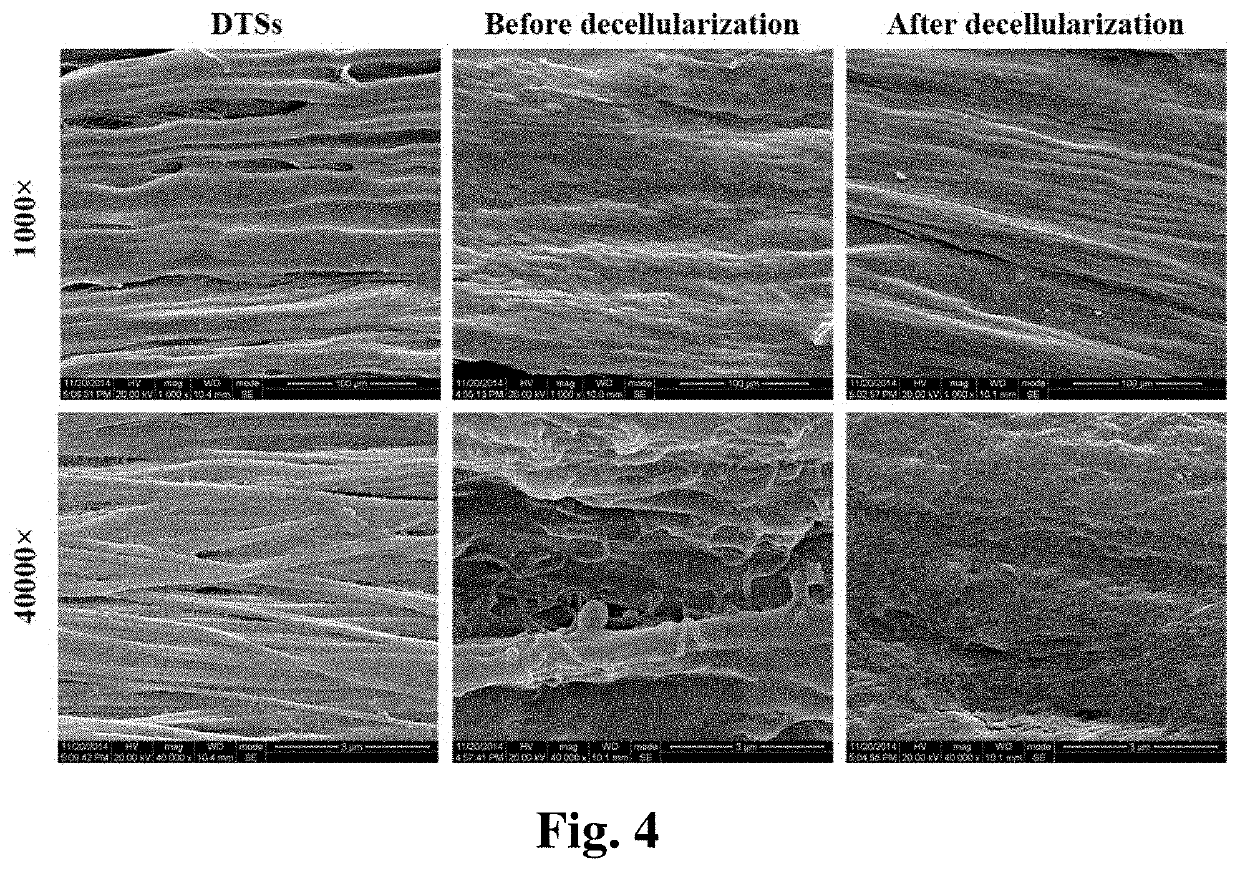Bioactive scaffold for inducting tendon regeneration, preparation method therefor and use thereof
a bioactive scaffold and inducting tendon technology, applied in the field of tissue engineering materials, can solve the problems of disease transmission and rejection, pain, infection, injury at the area where the donor tendons are located, etc., and achieve the effects of high added value, convenient storage and transportation, and high production efficiency
- Summary
- Abstract
- Description
- Claims
- Application Information
AI Technical Summary
Benefits of technology
Problems solved by technology
Method used
Image
Examples
example 1
, Preparing a Bioactive Scaffold for Inducing Tendon Regeneration
[0066]The bioactive decellularized tendon slice scaffold was prepared from Achilles tendon from a canine hind limb by longitudinally sectioning and was further modified by ECM of tendon-derived stem cells. The specific preparation method is as follows:
[0067](1) providing a fresh tendon tissue and wash it; (2) freezing and thawing the tendon tissue and repeating the process for 4 to 6 times, each process carried out by placing the tendon tissue in liquid nitrogen for 1 to 3 minutes, then at 25 to 37° C. for 3 to 10 minutes; (3) frozen sectioning longitudinally the tendon tissue to obtain slices having a thickness of 300 to 900 μm; (4) placing the slices in a solution having DNase at a concentration of 120 to 180 IU / ml and RNase at a concentration of 80 to 120 μm / ml either at room temperature or at 37° C. for 6 to 24 hours. Finally, freeze and disinfect the thus obtained decellularized tendon slice scaffold for future us...
example 2
, Preparing a Bioactive Scaffold for Inducing Tendon Regeneration
[0070]The bioactive decellularized tendon sheet scaffold was prepared from bovine Achilles tendon by compressing, decellularizing, and was further modified by the ECM of tendon-derived stem cells. The preparation method was based on the method of claim 1 of Patent No.: ZL201310636964.0. The specific preparation method is as follows:
[0071](1) providing a fresh tendon tissue and wash it; (2) compressing the tendon tissue along the thickness direction to reach a compression ratio of 60% to 90% and obtaining a tendon sheet with a thickness of about 1.0-1.2 mm; (3) freezing and thawing the tendon sheet and repeating the process for 4 to 6 times, each process carried out by placing the tendon sheet in liquid nitrogen for 1 to 3 minutes, followed by at 25 to 37° C. for 3 to 10 minutes; and (4) placing the tendon sheet in a solution having DNase at a concentration of 120 to 180 IU / ml and RNase at a concentration of 80 to 120 μ...
example 3
, Preparing a Bioactive Scaffold for Inducing Tendon Regeneration
[0074]1. Preparation Method
[0075]Bovine Achilles tendon was used to prepare a bioactive decellularized tendon sheet scaffold. Also, tendon gel was prepared. The preparation method was based on the method of claim 1 of Patent No.: ZL201310636964.0. The decellularized tendon sheet scaffold thus obtained was applied for repairing the Achilles tendon defects and reconstructing the Achilles tendon function on a rabbit. The specific preparation and use methods are as follows:
[0076]First, preparation of a decellularized tendon sheet scaffold: (1) providing a fresh tendon tissue and wash it; (2) compressing the tendon tissue along the thickness direction to reach a compression ratio of 60% to 90% and obtaining a tendon sheet with a thickness of about 1.0-1.2 mm; (3) freezing and thawing the tendon sheet and repeating the process for 4 to 6 times, each process carried out by placing the tendon sheet in liquid nitrogen for 1 to ...
PUM
| Property | Measurement | Unit |
|---|---|---|
| Temperature | aaaaa | aaaaa |
| Temperature | aaaaa | aaaaa |
| Fraction | aaaaa | aaaaa |
Abstract
Description
Claims
Application Information
 Login to View More
Login to View More - R&D
- Intellectual Property
- Life Sciences
- Materials
- Tech Scout
- Unparalleled Data Quality
- Higher Quality Content
- 60% Fewer Hallucinations
Browse by: Latest US Patents, China's latest patents, Technical Efficacy Thesaurus, Application Domain, Technology Topic, Popular Technical Reports.
© 2025 PatSnap. All rights reserved.Legal|Privacy policy|Modern Slavery Act Transparency Statement|Sitemap|About US| Contact US: help@patsnap.com



